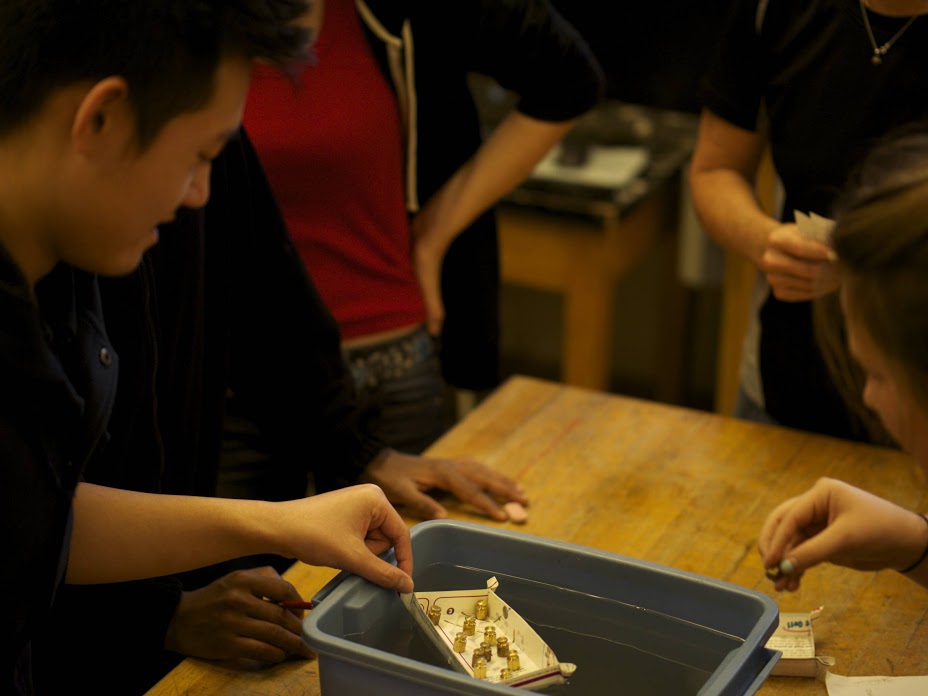Barges: STEM Competitions for grades 9 to 12
March 23, 2015 Filed in:
ArticlesRoberta Tevlin, Danforth Collegiate, Past President of OAPTCompetitions are a great way to motivate students, to provide a rich learning experience and incorporate the STEM disciplines and problem-solving approach. Unfortunately, it can be hard to find competitions that are appropriate. They need to be challenging but not impossible. They must use cheap materials and tools and should not require significant building skills. If possible, they should require precision in measurement and calculations. One competition that does all of these; and not only that, it has curriculum connections ranging from grade 9 Science to grade 12 Calculus, is “Barges”.
Each group is given a rectangular piece of Bristol board laminated on one side with packing tape. They are allowed to use scissors and staples — but no other tools — to make a barge that can support that maximum weight when placed in water. They are not allowed to test it until the competition. The weights are 10 g masses, so predictions have to be rounded up or down. The group with the highest prediction that floated wins the competition.

If you allow them to go through many iterations of this contest and rotate group members between contests, the class will eventually figure out the following:
- Don’t cut!!! What were you thinking? Just fold and staple.
- Make a rectangular barge — not a square barge — and it doesn’t need to be fancy. This is the best option because the starting material is rectangular.
- Use math! Make a rectangular barge carefully and then measure and calculate the volume accurately. Then use m = dV, using the density of water which is 1.00 g/cm3.
- There is a particular height that will give you the largest volume. This height can be found by guess and check calculations by hand or by using a formula in Excel. It can also be found by graphical analysis or calculus.
- The formula to calculate the volume is h*(L – 2h)*(w -2h) and not h*(L – h)*(w - h)!
- When you place the masses, you need to be careful to place them so that the barge is balanced. Never drop them!
- You should round up not down, because there is significant surface tension that can hold some extra weight. Watch what the maximum is in each competition and develop a rough formula for rounding up. It should be in the form of a percentage – not an absolute amount.
- Don’t waste the corners. Staple the edges so that the extra material sticks out and then open up this flap to provide extra buoyancy, surface tension and balance.
- If the shape is very long and narrow, the material may sag in the middle. You may need to sacrifice a bit of volume and fold it in the middle.
- For an Additional challenge: If the masses must be placed in a cup – rather than evenly spread across the bottom of the barge – you will have to make sure that the centre of mass of the cup is not above the water line.
As you can see this competition can be run at a simple level for grade 9’s and become very subtle for senior students. It can be used as an example of Unit A: Scientific Investigation Skills in any grade and has specific connections with 9 science (properties of materials), 11 physics (forces) and 12 physics (dynamics, mechanical systems). It fits in the math curriculum in grades 9 (volumes of solids), 11 (characteristics of functions) and 12 calculus (max. min problems).
“Competitions are a great way to motivate students, to provide a rich learning experience and incorporate the STEM disciplines and problem-solving approach…They need to be challenging but not impossible… use cheap materials and tools and should not require significant building skills.”
If you run a series of these competitions over several classes, you can use these experiences to have the students explore how to approach problem-solving with a group. After making many mistakes in this competition, they should try and develop some general principles that will help them avoid these in future situations. Here are two issues that tend to arise in one form or another.
- Everyone in the group needs to be fully engaged. Watch to see if anyone is dominating or being too reserved. The group needs to have a strategy to avoid this. Everyone needs to make suggestions and criticize the various options. Everyone should do the calculations.
- Every decision needs to be examined carefully and critically. Don’t get to a consensus too fast. Don’t just agree and be pleasant. You want to find the best solution — not an OK solution. Everyone needs to criticize the ideas and listen carefully to the criticisms. Remember, the ideas are being criticized — not you.
You can find more contest ideas and the details for a 2-year interdisciplinary course on my website
http://roberta.tevlin.ca/Engineering%20Contests/Engineering%20Contests.htm. It is lots of fun to teach, attracts great students to our school and is about as STEM-focussed as you can get. I am very interested in supporting any teacher who wants to use any of this material and I would love to hear back from teachers with criticisms and suggestions on how to improve it. Feel free to email me at
roberta@tevlin.ca.
Tags: Forces, Pedagogy, STEM


